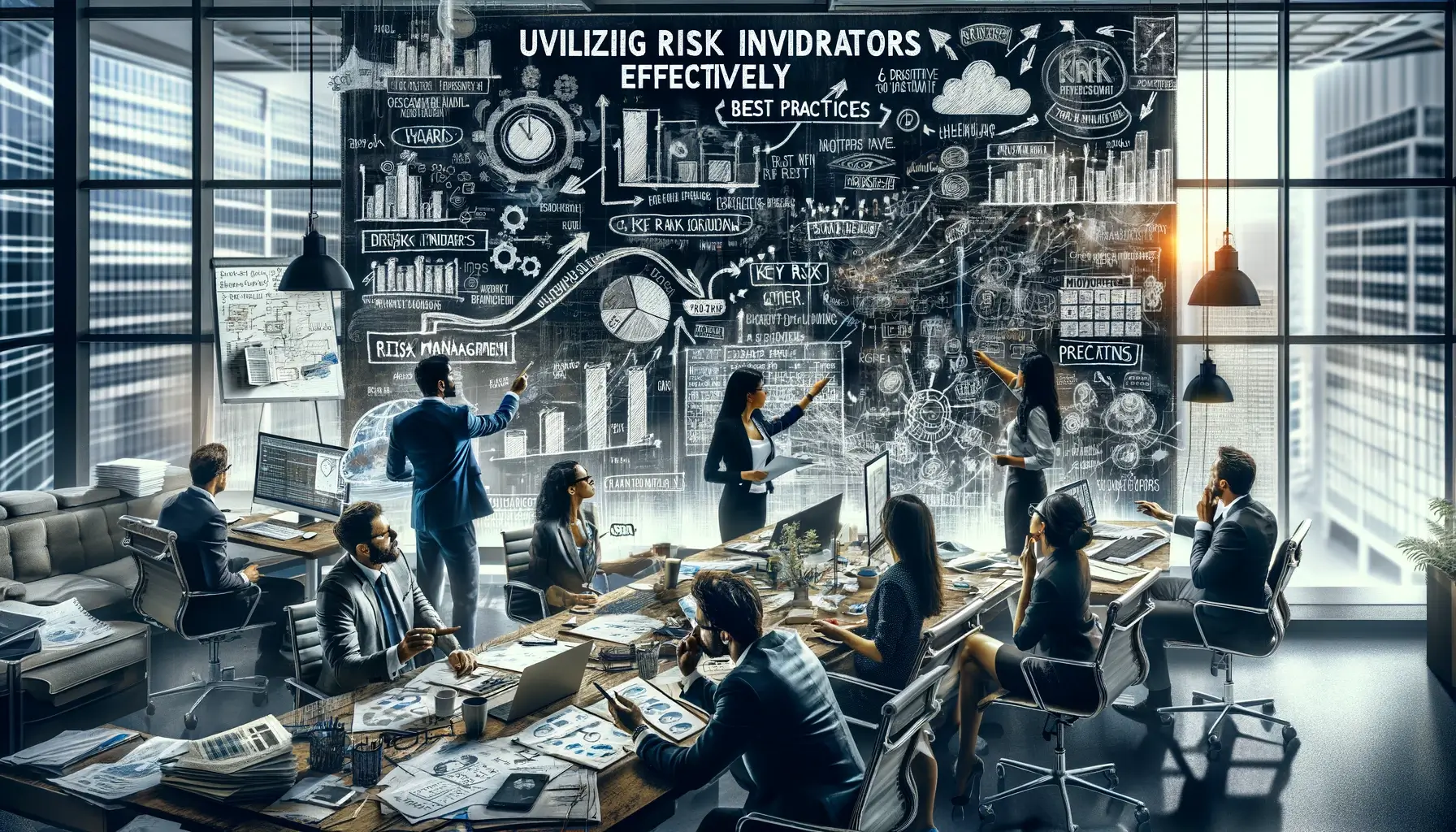In the field of risk management, Key Risk Indicators (KRIs) play a crucial role. KRIs are essential components of effective risk management frameworks, helping organizations to comprehend and manage potential threats.
This discourse delves into the fundamental principles underlying KRIs, from their definitions to their roles, illustrating their importance in modern organizational strategy.
It further explores the design and implementation of these indicators, elucidating methods and best practices that align with given organizational goals and strategies.
The final part provides an in-depth view of monitoring and refining KRIs over time to enhance risk management outcomes, exemplifying various techniques and methodologies.
Understanding Key Risk Indicators
Key Risk Indicators, often called KRIs, constitute an essential tool within an organization’s risk management framework.
A multi-dimensional concept, KRIs bridge the gap between theory and practice, providing concrete, quantifiable measures that aid in identifying, monitoring, and mitigating potential risks.
Employed across industries, they serve as invaluable barometers that gauge the potential threat of an event impacting an organization’s ability to achieve its objectives.
Risk indicators can be deemed an early-warning system, predicting the emergence of threats to operations, reputation, and finance that might otherwise lie hidden.
They operate in real-time, allowing for the timely generation of reports that spotlight risk trends, discrepancies, and disturbances before they become problematic.
To comprehend the essence of Key Risk Indicators, it is crucial to emphasize the distinction between the two leading types of risk indicators – leading and lagging. Leading indicators identify the potential risk areas before damage occurs.
Concurrently, lagging indicators survey the effects after an incident materializes, serving as a reflective learning tool for future risk prevention strategies.
The importance of KRIs stems from their capacity to offer a sophisticated, data-driven perspective to safeguard against latent threats.
Although no single measure can wholly ensure organizational safety, incorporating KRIs into a rigorous risk management strategy provides an additional layer of proactive protection.
Implementing an effective KRI framework depends on a systematic, structured approach that involves a detailed comprehension of organizational structure, industry trends, and regulatory requirements.
Adequate consideration must be given to the selection and development of KRIs to ensure they possess relevance, timeliness, and accuracy.
Key Risk Indicators encapsulate a proactive, collaborative, and data-informed ethos, fostering a resilient organizational architecture that can withstand adversities.
Remember, the sources for the KRIs can be as significant as the indicators themselves, requiring diligent exploration of internal databases, industry reports, employee feedback, and other relevant sources for a thorough and reliable risk indicator framework.
This broader outlook and proactive stance equip organizations with the ability to preemptively detect vulnerabilities, cultivate resilience, and adapt to the dynamic business ecosystem.
Key Risk Indicators are not just a protective mechanism, but also a strategic asset that shapes an organization’s risk culture, showcasing the synergy between risk management and business performance.

Design and Implementation of Key Risk Indicators
To progress the discourse on Key Risk Indicators (KRIs), it seems imperative to delve into the design and implementation process.
The constitution and deployment of these systematic measures necessitate a keen understanding of the organization’s structure, operation, and risk profile.
It’s a task that requires thoroughness and a strategic approach guided by industry best practices and learning from other organizations’ experiences.
Firstly, establishing a robust KRI framework calls for choosing relevant indicators that encapsulate the complete picture of the organization’s risk landscape. These indicators should be closely tied to the organization’s strategic objectives and its risk appetite.
The selection process should incorporate valuable inputs from different levels of the organization, involving key decision-makers, departmental heads, and frontline teams to ensure a comprehensive view of potential risks.
Secondly, KRIs must possess certain qualities to be of substantial value. They should be actionable, allowing for preventive steps to be taken before the actual risk occurs.
Additionally, reliability is crucial to ensure that the results obtained are neither erroneous nor misleading. They should also be timely, providing regular updates that paint a current image of the risk profile.
Hence, the indicators selected must stand the test of actionability, reliability, and timeliness.
An effective KRI design and implementation process also entails establishing risk thresholds for each indicator. Setting these thresholds requires a deep understanding the industry, market trends, and the organization’s risk-bearing capacity.
These thresholds are critical in identifying when risks are approaching unacceptable levels, thereby triggering corrective actions.
Accuracy and clarity in reporting are equally non-negotiable. KRIs should not overwhelm with excessive data but convey risk information concisely and clearly.
Utilizing visual data representations like graphs and charts that staff can quickly comprehend is an excellent mode of communication.
The frequency of reporting is another parameter to consider, decided by factors such as the organisation’s size, the dynamism of its environment, and the type of risks involved.
Finally, the successful deployment of KRIs must include regular reviews and updates. As the business environment changes, so will the risk landscape.
Regular reviews will ensure your KRIs remain relevant and accurate, providing meaningful insights into the organization’s risk profile. Indeed, flexibility and adaptability are key aspects of an effective KRI implementation strategy.
Indeed, the intricacies of Kris’s design and execution are manifold. However, with careful planning, consideration, and execution, they hold the potential to enhance an organization’s risk management capabilities significantly, in turn contributing to better performance and increased resilience.

Monitoring and Improving Key Risk Indicators
To ensure the effectiveness of Key Risk Indicators (KRIs), their performance must be continuously monitored and improved.
This involves a methodical approach that includes three key components: regular reassessment, data analysis, and performance feedback.
The first step revolves around the regular reassessment of the KRIs.
To ensure that KRIs remain relevant, organizations must periodically review and recalibrate them in line with changing business objectives, regulatory requirements, and macroeconomic conditions.
This involves assessing each KRI’s ability to accurately signal emerging risks, its responsiveness to alterations in the risk profile, and its compatibility with established risk thresholds.
The KRI reassessment should involve regular meetings, document reviews, and updated risk reports.
The second step is the competent analysis of collected KRI data. Accuracy and timeliness cannot be compromised in this phase.
The data gathered should be routinely scrutinized for trends, patterns, or anomalies. Statistical methods may be employed to detect any significant deviations, while visual analytics can aid in deciphering complex data sets.
Advanced technologies such as Artificial Intelligence and Machine Learning can be strategically used to mine and process large volumes of data, thus bolstering the efficiency of KRIs.
The final step is the feedback loop. Specific KRIs may underperform, yield inaccurate results or fail to provide early warnings. These instances should be treated as learning opportunities, and the data used to improve KRI performance.
Performance feedback comprises amendments to the choice, calculation, or presentation of KRIs. This feedback loop ensures that KRIs evolve in tandem with the organization’s risk management needs, hence, delivering continuous enhancement in performance.
Considering the dynamism in today’s business environment, the KRI framework should allow for adaptability. A typical mistake to avoid is to view KRIs as a static set of measures.
On the contrary, they should be perceived as a versatile toolkit that can be customized per requirement. Therefore, organizations should trade rigidity for flexibility while selecting, implementing, and reviewing KRIs.
Finally, although developing and efficiently using KRIs is a demanding task, its potential benefits cannot be underestimated. It leads to an enriched risk management capability, aiding organizations to anticipate and address vulnerabilities effectively.
This drives enhanced performance and resilience, forming a robust foundation for strategic decision-making and value creation.
Therefore, adopting best practices for monitoring and improving KRI effectiveness emerges as an imperative for modern-day risk management.

Conclusion
Enhancing knowledge and expertise on Key Risk Indicators is not just beneficial but essential for every business professional.
These indicators, if understood, designed, implemented, and monitored effectively, can significantly reduce the impact of potential risks and maintain the stability and growth of the organization.
The successful alignment of the organization’s goals and strategies with the design and implementation process amplifies the effectiveness of KRIs.
Following the presented techniques to continuously monitor and refine indicators, professionals can adapt to varying risk landscapes, ensuring long-term success through enhanced risk management outcomes.

Chris Ekai is a Risk Management expert with over 10 years of experience in the field. He has a Master’s(MSc) degree in Risk Management from University of Portsmouth and is a CPA and Finance professional. He currently works as a Content Manager at Risk Publishing, writing about Enterprise Risk Management, Business Continuity Management and Project Management.

